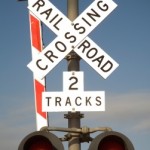Fatal Vehicle-Train collisions can often be prevented
 Last week, WNEP news reported that two men died in Lycoming County after the pickup truck they were riding in collided with a freight train. Police reported that the truck was driving over a railroad crossing when it collided with a Norfolk Southern Train.
Last week, WNEP news reported that two men died in Lycoming County after the pickup truck they were riding in collided with a freight train. Police reported that the truck was driving over a railroad crossing when it collided with a Norfolk Southern Train.
About every 3 hours a person or vehicle is hit by a train, according to Operation Lifesaver, a non-profit organization focused on providing education to prevent collisions at a railroad track and highway-rail grade crossings. The average locomotive weighs about 400,000 pounds or 200 tons and can weigh up to 6,000 tons. This makes the weight ratio of a car to a train proportional to that of a soda can to a car. By the time a locomotive engineer sees a person or vehicle on the tracks, it is often too late. It takes a freight train traveling at 55 mph more than a mile, or the length of 18 football fields, to stop.
According to statistics reported by the Federal Railroad Administration (FRA), there were 2,087 highway-rail incidents at public and private crossings in 2013, resulting in 251 fatalities and 929 injuries. As the statistics show, these accidents can be catastrophic but are often preventable. Many of these accidents occur either because the driver fails to see the train coming, or makes a decision to race through the crossing.
Although it might seem impossible that a driver could miss something as large and loud as a train coming, it happens often. One reason may be that safety measures, such as warning lights at some of these crossings are much less effective than those at normal highway intersections. Some may have nothing more than a sign. Figures from the National Transportation Safety Board (NTSB) state that approximately 60% of all railroad crossing fatalities occur at unprotected or passive crossings.
The Association of American Railroads reported that there are approximately 210,000 crossings in the U.S., for which state and local governments are responsible for the installation of active warning devices. While federal, state and local governments are responsible for the installation of these devices, railroads are responsible for the maintenance of the devices. Railroads can also choose to install safety devices on their own, without waiting for government assistance and to help save lives. The FRA estimates about 80% of railroad crossings do not have adequate warning signs.
An important move to improve safety is the installation of flashing lights and automatic gates signal systems at all crossings. Statistics show that this could help prevent 94% of collisions at crossings. This important measure can save hundreds of lives each year.
Here are some tips from the personal injury lawyers at Munley Law Personal Injury Attorneys to help ensure your safety at railroad crossings:
- Stop, look and listen when approaching a railroad crossing.
- Always look in both directions before crossing the tracks.
- Do not race a train to a crossing, as the results could be deadly.
- Never drive around lowered gates.
- Never stop on the train tracks.
- Only cross the tracks at a designated railroad crossing.
- If you get stuck on the track while crossing, immediately leave your vehicle and call for help.
If you have been injured in an accident with a train, the personal injury lawyers at Munley Law Personal Injury Attorneys can help. We’ve represented thousands of accident victims and their families in Pennsylvania, New York and New Jersey. Call Munley Law Personal Injury Attorneys today for a free consultation. Call 855-866-5529 or visit www.munley.com.
Posted in Car Accidents.









